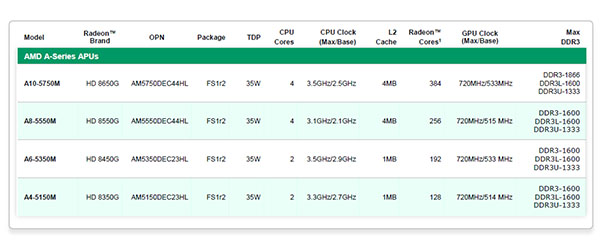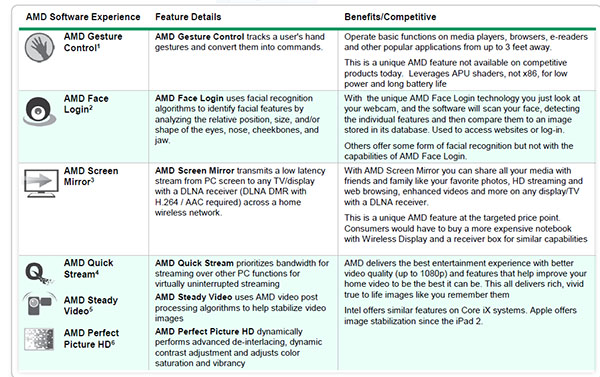AMD used the pretext of the Consumer Electronics Show (CES) at the turn of the year to, in broad strokes, reveal its Accelerated Processing Unit (APU) strategy for 2013. Though no solid time-frames were put forward at the unveil, reading between the lines, AMD indicated that it would debut the Richland APU, to replace incumbent Trinity for performance A-series mobile and desktop machines.
The time for Richland to be revealed in a little more detail is now. The Richland APU is considered a refresh of Trinity. This means that it uses the same base geometry and architecture as found on the chip released last year, but the interim time has provided AMD with the opportunity of refining the design such that Richland APUs run at higher clocks, use better thermal/power management and offer up to 30 per cent more application performance - all at the same TDP.
Just like Trinity's arrival, AMD is focussing on the laptop market first and then releasing the desktop variants at a later date, which is currently unknown. Richland is the codenamed used by AMD and, by extension, the press, but the parts will continue to be marketed under the A4, A6, A8, and A10 models. What will change, as with any quasi-generational bump, is the model-numbering suffix.
The new Richland APUs
AMD has informed us that the four Richland-based APUs, listed above, are already shipping to large-volume laptop customers, and will be on the shelves in the next month or so, depending upon region. Note that, while there has been no manifest change in underlying architecture, AMD is bumping the APU suffix to the 5xxM (from 4xxM) and the integrated graphics to HD 8xxG (up from HD 7xxG). And when we say no change in architecture, the same applies to the graphics portion, which is based on the same Northern Islands architecture found on Trinity, not on the newer, better Graphics Core Next (GCN). We'll have to wait for the full A-series APU refresh, codenamed Kaveri, before there are honest-to-goodness silicon alterations afoot.
We're somewhat miffed that AMD is raising the model numbers without a complimentary overhaul of the Piledriver cores and Northern Island graphics. AMD says that it feels comfortable in doing so - and, indeed, has to do so, to sate the needs of large OEMs who require a year-on-year 'improvement' - because the overall Richland performance is better than the comparable Trinity parts. Call us old-fashioned, or worse, but such an approach stretches the credibility of an engineering firm such as AMD. Let's examine the vital statistics of the two best-performing Richland and Trinity mobile APUs to see if we're being harsh with our credibility denunciation.
APU Model |
CPU Cores |
CPU Base Clock |
CPU Turbo Clock |
GPU Brand |
GPU Cores |
GPU Base Clock |
GPU Turbo Clock |
Max. DDR3 |
Package |
TDP |
|---|---|---|---|---|---|---|---|---|---|---|
| A10-5750M | 4 |
2.5GHz |
3.5GHz |
HD 8650G |
384 |
533MHz |
720MHz |
1,866MHz |
FS1r2 |
35W |
| A10-4600M | 4 |
2.3GHz |
3.2GHz |
HD 7660G |
384 |
497MHz |
686MHz |
1,600MHz |
FS1r2 |
35W |
A10-5750M (Richland) versus A10-4600M (Trinity) appears to be all about changes in top-end frequency; the architecture is the same. The A10-5750M can run almost 10 per cent faster on the CPU, five per cent speedier on the GPU side of things, and 16 per cent on the memory. Take these into account and the putative 20-30 per cent performance gains clearly aren't exhibited on the top chips of each series, and we believe that AMD is using GPU-based figures, which are particularly partial to increases in memory bandwidth, in its marketing.
Eking out extra speed
You may wonder about the technical explanation for how AMD has eked out extra frequency. The main reason why Trinity-beating clocks can be run at the same TDP rests with how power is allocated to the chip. With Trinity, the general assumption is that if the CPU or GPU (or both) call for extra power, then there is a good reason for the chip to allocate its power budget to the required resource. For example, run Prime95 and the CPU portion of the APU demands all the power; the power-delivery algorithm happily obliges. However, many under-load cases are not always as simple as that.
For instance, a gaming scenario may automatically encourage the Trinity APU's power algorithm to shunt the majority of power to the GPU, but perhaps when the game engine is CPU-limited to some degree, a chunk of power is better spent on providing the CPU more of the overall budget - something that Trinity APUs are not so good at. Individual cases are more complex than just flicking the power switch on/off to any part of the APU; one need to understand the context in which power is demanded.
The microprocessor in charge of Richland's temperature-controlled power-delivery system takes a whole bunch of factors into account before deciding how best to farm out the available power, including application environment (as above), ambient environment (general temperature) and cooling used. Assuming that this all works as advertised, sensibly getting power to where it's needed most appears to have been improved in Richland, though, at this juncture, we have no way of verifying these claims. Additionally, AMD says that it has a greater number of P-states in the new APUs. P-states define the relationship between power and frequency, and adding more points gives the APU a greater number of choices when selecting the optimum frequency/voltage.
AMD says that it has also improved the power-delivery system when the APU is idling, under minor load and when playing video. This is especially important as most laptops are in one of these three states the vast majority of the time, so while it's nice having increases in flat-out power, such occasions are few and far between.
Richland's silicon-level improvements translate to marginally better idle and WiFi browsing battery life when compared to what appears to be an equivalent Trinity laptop. The real gain is with respect to 720p video playback, where Richland's video block has been aggressively tuned for low-power usage, according to AMD. The exact power-saving mechanisms used are unclear at present.
Not just about the hardware
AMD perhaps appreciates the hardware changes from Trinity to Richland, detailed above, aren't enough on their own. This is why it is introducing three Richland-only software 'experiences' with the new APU. There's no technical reason why the free AMD Gesture Control, Face Login, and Screen Mirror features cannot be run on Trinity APUs, but they'll be reserved for the latest APUs, with Trinity users limited to the three already-available experiences at the bottom of the slide. The most interesting Richland-only feature appears to be Screen Mirror - an Intel Widi-like, wireless transmitting feature that, AMD contends, will be available, as standard, on sub-$500 laptops for the first time. Be aware that AMD further limits certain experiences for a particular class of A-series chip. You'll need an A8 or A10 for Gesture Control, for example, and at least an A6 for Screen Mirror.
The wrap
In a nutshell, Richland is the refresh to the extant Trinity APUs that power most mainstream AMD laptops today. There's very little in the way of architecture change, mind, and any performance improvements are made possible through higher frequencies and better power management. The transition between Trinity and Richland APUs is helped by keeping to the same chip form factor, and this means that laptop manufacturers will have minimal work in qualifying existing laptop ranges.
We feel AMD has to release a new A-series APU range in early-2013 because it is expected to do so; laptop partners, retailers and consumers want to see 'new' technology. Richland, by its very design, incrementally improves upon Trinity, thus making a competent platform that bit more appealing. We'll have to wait a little while until low-power (17W) versions of the APU surface and until later this year for a brand-new mainstream APU design, dubbed Kaveri. Richland, then, is very much a stop-gap born from the need to showcase new parts.
















